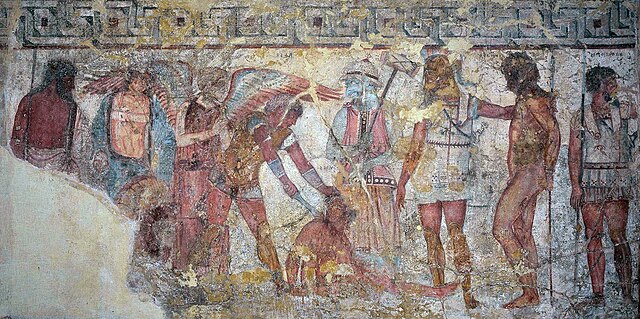Briseis, also known as Hippodameia, is a significant character in the Iliad. Her role as a status symbol is at the heart of the dispute between Achilles and Agamemnon that initiates the plot of Homer's epic. She was married to Mynes, a son of the King of Lyrnessus, until the Achaeans sacked her city and was given to Achilles shortly before the events of the poem. Being forced to give Briseis to Agamemnon, Achilles refused to reenter the battle.
Briseis and Phoenix, red-figure kylix, c. 490 BC, Louvre (G 152)
Achilles' surrender of Briseis to Agamemnon, from the House of the Tragic Poet in Pompeii, fresco, 1st century AD, now in the National Archaeological Museum, Naples
Briseis smelling a flower, red-figure pottery, ca. 520-510 BC, British Museum.
Abduction of Briseis, 4th century
The Iliad is one of two major ancient Greek epic poems attributed to Homer. It is one of the oldest extant works of literature still widely read by modern audiences. As with the Odyssey, the poem is divided into 24 books and was written in dactylic hexameter. It contains 15,693 lines in its most widely accepted version. Set towards the end of the Trojan War, a ten-year siege of the city of Troy by a coalition of Mycenaean Greek states, the poem depicts significant events in the siege's final weeks. In particular, it depicts a fierce quarrel between King Agamemnon and a celebrated warrior, Achilles. It is a central part of the Epic Cycle. The Iliad is often regarded as the first substantial piece of European literature.
Inscription of lines 468–473, Book I. 400–500 AD, from Egypt. On display at the British Museum
Iliad, Book VIII, lines 245–253, Greek manuscript, late 5th, early 6th centuries AD
Thetis at Hephaestus' forge waiting to receive Achilles' new weapons. Fresco from Pompeii, 1st century
A detail of fresco from the François Tomb at Vulci, showing the sacrifice of Trojan slaves. From left to right: Agamemnon, ghost of Patroclus, Vanth, Achilles beheading a slave, Charun, Ajax the Great, a slave, Ajax the Lesser. 350-330 BC








